Endangered right whales migrate to Florida’s Atlantic Coast from December to March
Manatees may be the most lovable and panthers are the rarest, but Florida’s biggest endangered mammal may be one you didn’t know about — the northern right whale.
Right whales, which can grow to 70 tons and 55 feet long, are sighted every winter off the Atlantic coast between Jacksonville and Cape Canaveral.
Hundreds of volunteers, plus visitors and residents of the northeastern coast, get the thrill of a handful of whale sightings between December and March each year. There are no excursions to do whale watching in Florida; sighting them is too rare.
Scientists estimate there are only about 360 right whales including fewer than 70 calving females.
North Atlantic right whales are dying faster than they can reproduce. The primary threats to the species are entanglements in fishing gear and vessel strikes. Learn more about the status of the right whale here.
Some predict the right whale will be extinct in 20 years.
In 2023-24, 19 calves were sighted in the Southeastern U.S. This number was better than during recent winters, but sadly, not all of the calves survived. One calf died following a vessel strike and four are presumed dead after they went missing.
Scientists estimate we would need 50 or more calves each winter to offset the current rate of mortality. During the early 2000s, the whales averaged 24 births per year.
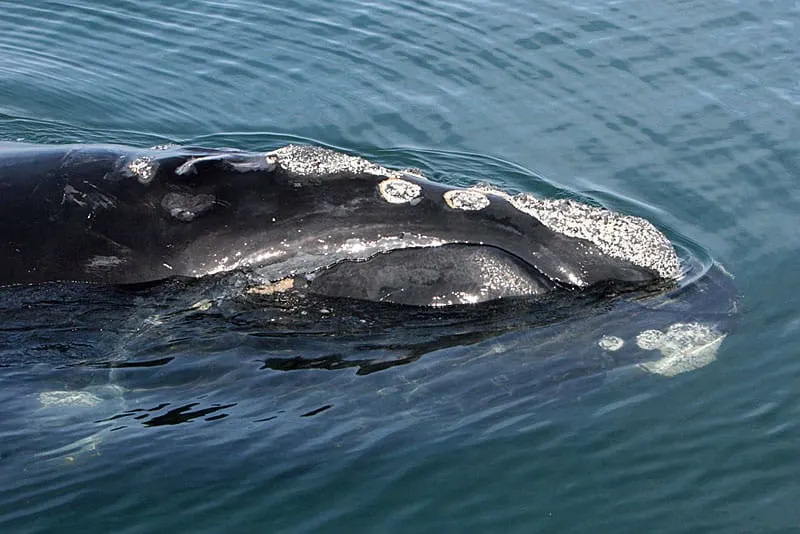
Right whales summer off New England and Nova Scotia. In November, some of the females, a few adult males and assorted juveniles migrate south for the winter.
By December, they’re acting like tourists, lolling around the beaches off Florida’s northern coast. The whales, however, are here on serious business: Some of the females are pregnant and it is in these waters northern right whales give birth to calves and nurse them. In March, it’s time to head north again.
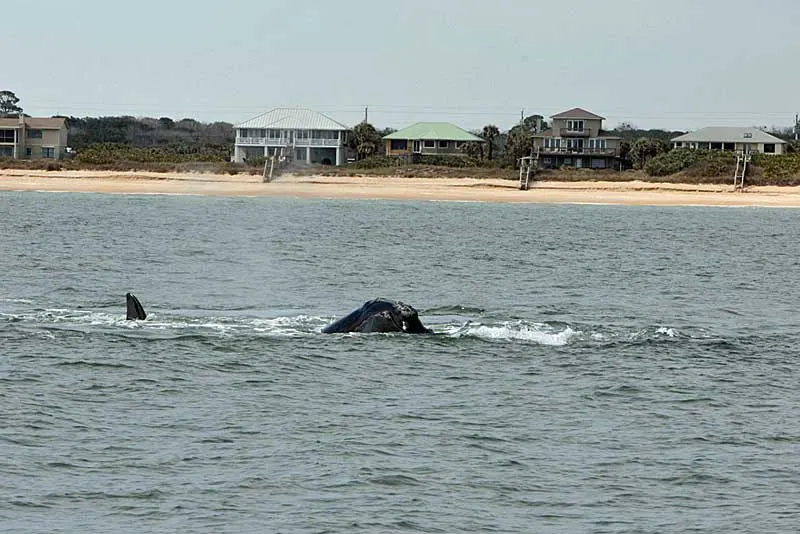
About 100 to 150 whales make the visit to Florida shores each year, according to Joy Hampp, project coordinator for the Marineland Right Whale Project for the last decade.
Why are they “right” whales? Because early whalers appreciated that their high blubber content made them float when dead. Whalers reduced the population to a few dozen by 1900.
Right whales can live 50 or 60 years and are slow to reproduce.
Calves are born at about 2,000 pounds and 15 feet long. They can’t hold their breath long so they and their mothers must spend more time at the surface while in Florida, Hampp said.
Tips for whale watching in Florida
Unless you live near the beach in northeastern Florida, consider yourself blessed if you experience one right whale sighting in your lifetime.
Some years whale observers with the Marineland Right Whale Project count fewer than 10 sightings all season.
Visitors to the coast between St. Augustine and Daytona Beach can’t count on a whale sighting — there are too few whales for that. But there are worse ways to spend an afternoon than hanging out on a Florida fishing pier scanning the ocean.
If you visit the Atlantic Coast between Cape Canaveral and Jacksonville in the winter, here’s how to increase your chances of spotting a whale, according to Joy Hampp:
- Keep binoculars handy, but scan the ocean without them from any higher vantage point.
- Whales are often in the company of dolphins with sea birds overhead, so if you see either of those, take a closer look for whales.
- The most likely way you’ll spot a whale? First you’ll see a lot of cars and a clump of people on the shoreline pointing and looking at the sea with binoculars. Since Flagler Beach has six miles of beachfront visible along A1A, it is a likely place to come upon a whale sighting in progress.
- You can identify right whales by these characteristics: They spout a V-shaped spray of water; they have no dorsal fin; they have whitish patches of raised and roughened skin (called callosities) on top of their heads, and their tales are black on both sides.
- Humpback whales do migrate through the same waters on their way to their Dominican Republic winter waters, but they move through earlier and later than right whales.
- Right whales have been spotted off the coast of Florida in the Gulf of Mexico.
- February seems to be the best month for whale sightings, though whales are present and observed from December to March.
- There are four fishing piers that make good whale-watching spots: The St. Augustine pier, the 800-foot-long pier in Flagler Beach, the Sunglow pier in Daytona Beach Shores and the Main Street pier in Daytona Beach.
About the Marineland Right Whale Project
With a patchwork of federal, state and private funding, the Marineland Right Whale Project coordinates volunteer teams with scientists in right-whale conservation efforts. It is not associated with the Marineland oceanarium.
Before and during the season, phone cards with right whale sighting information are distributed to residents, visitors, lifeguards and others who spend time at the beach. People are encouraged to phone the Right Whale Hotline — 1-888-97-WHALE –– if they see a whale. Each sighting triggers a follow-up visit by a response team of experienced individuals with cameras and GPS units who document whale movements and behavior. Teams track the whales as long as possible, sometimes for an entire day.
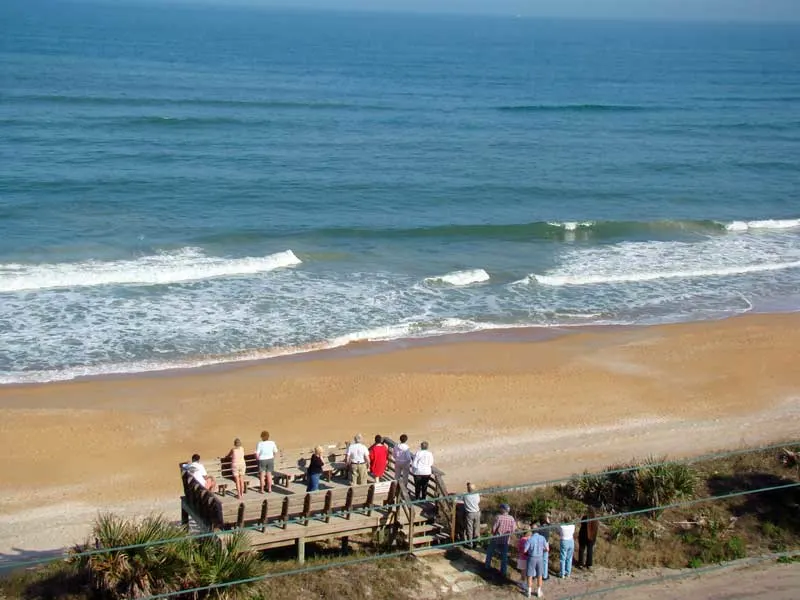
Facts about right whales in Florida
- Right whales have been hunted for centuries for their blubber and oil
- One of the major causes of death for the right whales today is collisions with ships.
- Right whales feed on large schools of zooplankton and scientists do not believe they eat while in Florida, where this food source is not available in sufficient quantities.
- The right whale is one of the slowest swimmers of all the whales, rarely going faster than 5 miles per hour. They are known to be quite active, however, as they breach, lobtail and tail-slap.
- The whales have been protected from hunting since 1949.
For information about right whales in Florida:
- Marineland Right Whale Project blog.
- Northern Right Whale facts from NOAA
- Ten things you probably didn’t know about right whales
- If you spot a whale in Florida, call the whale hotline: 1-888-97-WHALE
- Right Whale Festival Fernandina Beach
Tips for boaters during right whale season
From the Florida Fish and Wildlife Conservation Commission
- Go slow, which can give you time to react.
- Post a lookout! Watch for black objects, whitewater and splashes.
- Avoid boating in the dark, when visibility is poor or in rough seas.
- Use the Whale Alert app to see if whales have been sighted in your area.
- Check for signage at your local boat ramp or marina as a reminder of what to look for and how to identify and report right whale sightings.
- If a whale is spotted, slow down, operate at a slow speed or put your engine in neutral if possible. Assess the scene and slowly leave the area while keeping watch. Never pursue or follow a whale and keep at least 500 yards from the right whales (it’s the law).
- Report whale sightings and collisions immediately to the U.S. Coast Guard on marine VHF Ch. 16 or call 1-877-WHALE-HELP (942-5343).
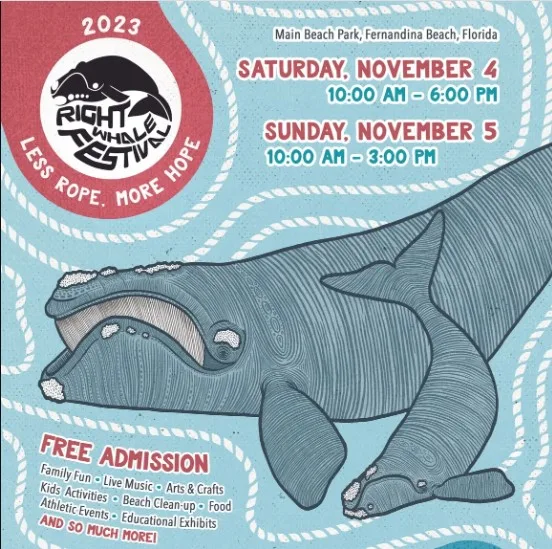
The Right Whale Festival: November 2024, in Fernandina Beach
Ever winter, NOAA Fisheries and other partners kick off the season with the annual Right Whale Festival at Main Beach in Fernandina Beach. The free, two-day family event celebrates the endangered North Atlantic right whale’s upcoming return to northeast Florida. North Atlantic right whale calving season begins in mid-November and runs through mid-April.
This family-fun event raises awareness of the threats to right whales and how we can help in their recovery. The festival highlights local efforts to protect these whales from extinction, as well as ocean-themed activities and exhibits that emphasize education and environmentally responsible adventures and products.
Family fun, live music, arts and crafts, kids activities, beach clean-up, educational exhibits, athletic events, food, live music and more.
For more information: http://www.rightwhalefestival.com
Things to do near Flagler Beach and St. Augustine
- Florida A1A has its most scenic section along this stretch of the coast. It’s a beautiful drive.
- St. Augustine, ideal for nature and history lovers
- Fort Matanzas, 14 miles south, is a smaller Spanish fort built 50 years after the Castillo de San Marcos. It’s a great stop because you take a small boat to the fort past spectacular scenery. And it’s free.
- Princess Place Preserve, a nearby county park with an 1888 hunting lodge once owned by a princess. Good hiking and camping. Free.
- Washington Oaks Gardens State Park: Historic gardens plus unusual coquina-rock beach.
- Flagler Beach, an Old Florida beach town.
- Tomoka State Park, gateway to the Ormand Scenic Loop and Trail, a lovely ride, including along the beach past prime whale-watching sites.
- Faver-Dykes State Park, large park good for kayaking, canoeing and birding along Pellicer Creek.
- Driving on the beach in northeastern Florida is the ultimate scenic drive.
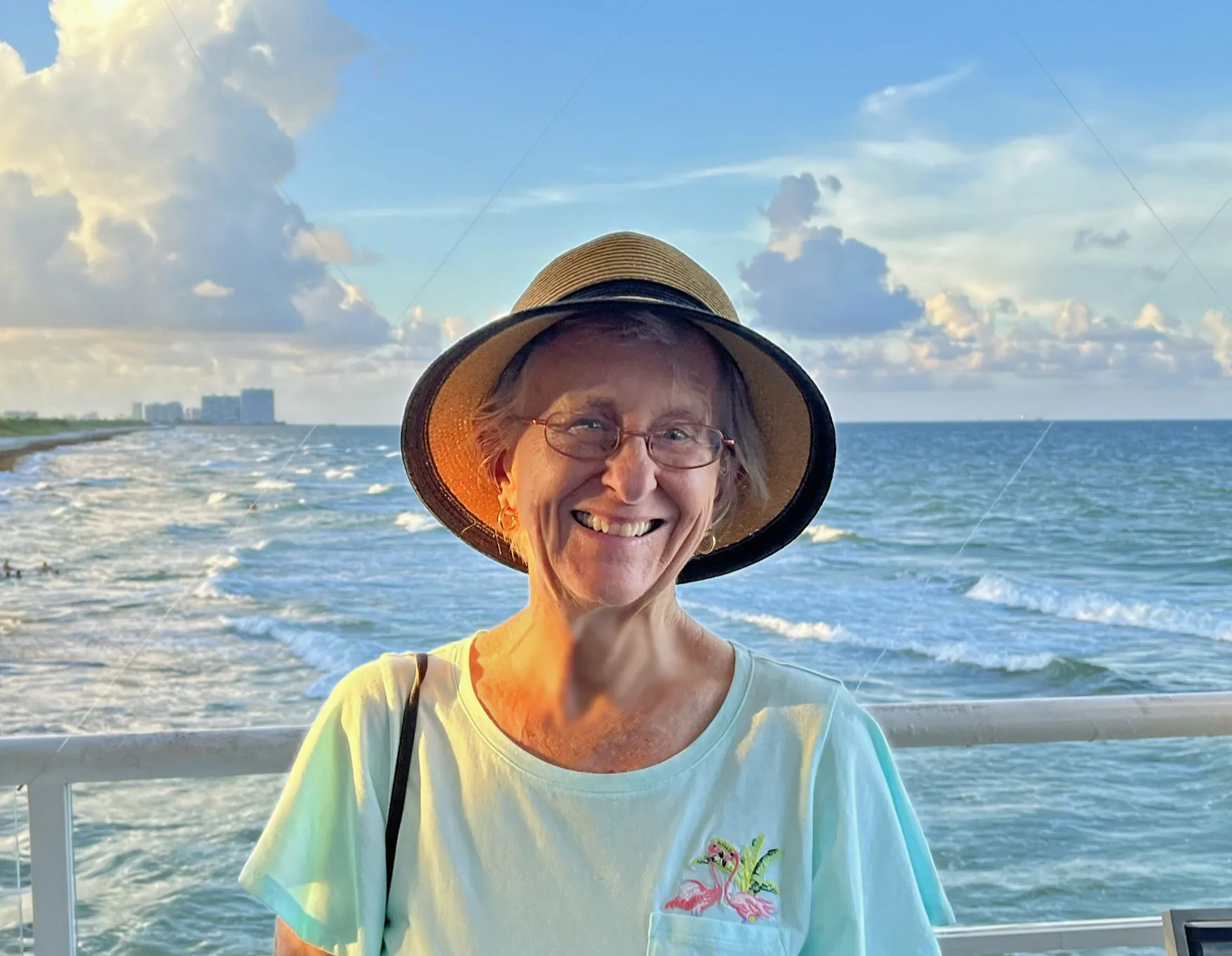
The author, Bonnie Gross, travels with her husband David Blasco, discovering off-the-beaten path places to hike, kayak, bike, swim and explore. Florida Rambler was founded in 2010 by Bonnie and fellow journalist Bob Rountree, two long-time Florida residents who have spent decades exploring the Florida outdoors. Their articles have been published in the Sun Sentinel, the Miami Herald, the Orlando Sentinel, The Guardian and Visit Florida.


Rose
Sunday 4th of March 2018
Concerned about the mining plans in the Atlantic Ocean whereby they will be using an air hammer like device on ships for tapping making huge sound vibrations, worried it will destroy our whale populations and whale families besides other marine destruction. Read about plans politicians approved and I am very upset.
Joe Kulpe
Wednesday 7th of February 2018
Wife and I in Melbourne, Florida, Dec 18-23. Got movie of single big Right Whale. Also seen: 4 together, 1 big, 1 med, 2 babies.
Sandra F Gardner
Saturday 6th of May 2017
My friend and I spotted a whale last week while visiting Fernandina Beach. It was an awesome sight. The first we have seen in this area.
Georgia belcher
Monday 2nd of January 2017
How do you become a volunteer spotter?
Bonnie Gross
Monday 2nd of January 2017
Here's info on the monitoring effort: http://www.aswh.org/whale/newmain.html
It looks like you can contact them here: [email protected]